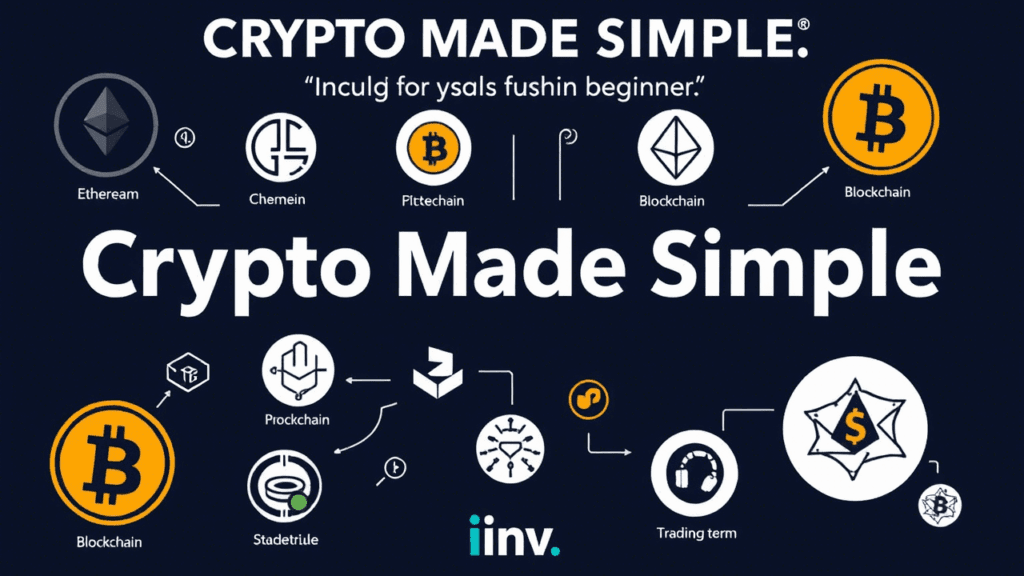To ensure clarity and understanding, here’s a comprehensive glossary of key terms referenced in “Crypto Compass: Navigating the World of Cryptocurrency Analysis – From Scratch to In-Depth Market Insights.” These definitions are designed to help you navigate the complex world of cryptocurrency with confidence.
🔤 A IS FOR…
- Address (Crypto Address): A string of alphanumeric characters used to send and receive cryptocurrency. Think of it as your bank account number for digital assets.
- Altcoin: Any cryptocurrency other than Bitcoin. Examples include Ethereum (ETH), Solana (SOL), and Cardano (ADA).
- ATH (All-Time High): The highest price ever reached by a cryptocurrency or asset.
- ATL (All-Time Low): The lowest price ever reached by a cryptocurrency or asset.
🅱️ B IS FOR…
- Bear Market: A prolonged period during which prices decline significantly, often driven by pessimism and selling pressure.
- Bitcoin (BTC): The first and most well-known cryptocurrency, created by Satoshi Nakamoto in 2009. It operates on a decentralized blockchain network.
- Blockchain: A distributed ledger technology that records transactions across multiple computers in a secure, transparent, and immutable way.
- Bull Market: A prolonged period during which prices rise significantly, often fueled by optimism and increased demand.
🌐 C IS FOR…
- Candlestick Chart: A type of chart used in technical analysis to display price movements over time. Each “candle” shows the open, high, low, and closing prices for a specific timeframe.
- Cold Wallet: A hardware device or offline storage method used to securely store private keys and protect cryptocurrencies from hacking.
- Consensus Mechanism: The process by which nodes (computers) on a blockchain agree on the validity of transactions. Common mechanisms include Proof-of-Work (PoW) and Proof-of-Stake (PoS).
- Cryptocurrency: A digital or virtual currency secured by cryptography, making it nearly impossible to counterfeit or double-spend.
🧠 D IS FOR…
- DAO (Decentralized Autonomous Organization): An organization governed by smart contracts rather than traditional leadership structures. Decisions are made collectively by token holders.
- DeFi (Decentralized Finance): A system of financial applications built on blockchain networks that aim to replace traditional intermediaries like banks with decentralized protocols.
- Dollar-Cost Averaging (DCA): An investment strategy where an investor buys a fixed dollar amount of an asset at regular intervals, regardless of price fluctuations.
⚙️ E IS FOR…
- ERC-20: A widely adopted standard for creating tokens on the Ethereum blockchain. Many popular cryptocurrencies, such as USDT and UNI, follow this standard.
- Ethereum (ETH): A decentralized platform that enables developers to build and deploy smart contracts and decentralized applications (dApps). Its native cryptocurrency is Ether (ETH).
😨 F IS FOR…
- Fear & Greed Index: A metric used to gauge market sentiment based on factors like volatility, trading volume, and social media activity.
- Fiat Currency: Traditional government-issued money, such as the U.S. Dollar (USD) or Euro (EUR), not backed by physical commodities like gold.
- FOMO (Fear Of Missing Out): A psychological phenomenon where investors rush to buy an asset due to fear of missing out on potential gains.
- Fork: A change in a blockchain’s protocol that creates two versions of the chain—one following the old rules and one adopting the new rules. Forks can be soft (backward-compatible) or hard (irreversible).
🔥 H IS FOR…
- HODL: A misspelling of “hold,” now commonly used as slang among crypto enthusiasts to mean holding onto an asset despite price volatility.
- Hot Wallet: A software-based wallet connected to the internet, making it convenient for frequent transactions but more vulnerable to hacks compared to cold wallets.
💡 I IS FOR…
- ICO (Initial Coin Offering): A fundraising method in which new projects sell their underlying tokens in exchange for established cryptocurrencies like Bitcoin or Ethereum.
- Immutability: The inability to alter data once it has been recorded on a blockchain, ensuring transparency and trust.
- Inflation: The rate at which the general level of prices for goods and services rises, eroding purchasing power. Cryptocurrencies like Bitcoin are often seen as hedges against inflation.
🕵️♂️ K IS FOR…
- KYC (Know Your Customer): A regulatory requirement for businesses to verify the identity of their clients to prevent fraud and money laundering.
💧 L IS FOR…
- Ledger: A record of all transactions on a blockchain. It is maintained by nodes (computers) participating in the network.
- Liquidity: The ease with which an asset can be bought or sold without affecting its price. High liquidity indicates a healthy, active market.
- Long Position: An investment strategy where an individual buys an asset expecting its value to increase over time.
⛏️ M IS FOR…
- Market Cap (Market Capitalization): The total value of a cryptocurrency’s circulating supply, calculated as Price × Circulating Supply.
- Mining: The process of validating transactions on a blockchain using computational power. Miners are rewarded with newly minted coins.
- Metaverse: A collective virtual space where users interact with each other and digital environments, often facilitated by blockchain technology and cryptocurrencies.
🖼️ N IS FOR…
- NFT (Non-Fungible Token): A unique digital asset representing ownership of items like art, music, or in-game objects. Unlike fungible tokens (e.g., Bitcoin), NFTs cannot be exchanged on a one-to-one basis.
- Node: A computer connected to a blockchain network that helps validate and relay transactions.
🔐 P IS FOR…
- Private Key: A secret string of characters that allows access to a cryptocurrency wallet and authorizes transactions. Keep it safe—it’s like your password!
- Proof-of-Stake (PoS): A consensus mechanism where validators lock up (“stake”) their cryptocurrency to participate in transaction validation. Energy-efficient alternative to PoW.
- Proof-of-Work (PoW): A consensus mechanism requiring miners to solve complex mathematical puzzles to validate transactions and add blocks to the blockchain. Used by Bitcoin.
- Public Key: A cryptographic code associated with a private key, acting as the address others use to send cryptocurrency to your wallet.
📈 R IS FOR…
- Resistance Level: A price point where selling pressure typically prevents further upward movement.
- RSI (Relative Strength Index): A technical indicator ranging from 0 to 100 that measures whether an asset is overbought or oversold.
🧾 S IS FOR…
- Smart Contract: Self-executing contracts written in code that automatically execute predefined actions when certain conditions are met. Popularized by Ethereum.
- Stablecoin: A cryptocurrency pegged to the value of another asset, usually fiat currency (e.g., USDT, USDC), to reduce volatility.
- Support Level: A price point where buying pressure typically prevents further downward movement.
🔄 T IS FOR…
- Token: A digital representation of value built on top of an existing blockchain. Tokens can represent utility, governance rights, or even real-world assets.
- Transaction Fee: A small fee paid to miners or validators for processing a transaction on the blockchain.
- Trading Pair: Two currencies traded against each other in a market. For example, BTC/USD represents Bitcoin priced in U.S. Dollars.
📊 V IS FOR…
- Volatility: The degree to which the price of an asset fluctuates over time. Cryptocurrencies are known for their high volatility.
- Volume: The total number of units of a cryptocurrency traded within a given timeframe. Higher volumes indicate greater market activity.
🧳 W IS FOR…
- Wallet: A tool for storing, sending, and receiving cryptocurrencies. Can be hot (online) or cold (offline).
- Whale: An individual or entity holding a large amount of cryptocurrency, capable of influencing market prices through trades.
- Whitepaper: A detailed document outlining a cryptocurrency project’s vision, technology, roadmap, and tokenomics.
🌾 Y IS FOR…
- Yield Farming: A DeFi practice where users lend or stake their cryptocurrencies to earn rewards, often in the form of interest or additional tokens.
By familiarizing yourself with these terms, you’ll be better equipped to understand the nuances of cryptocurrency analysis and make informed decisions. Use this glossary as a quick reference whenever you encounter unfamiliar jargon while exploring the exciting world of crypto!





